
ADI Standards Check training in
Nottingham. Make sure you’re a client centred driving instructor.
From April 2014 the check test for driving instructors is out and the ADI standards check is in. This new approach moves the focus on  to sharing the responsibility for learning with your pupils. Client centred learning as it’s called. You will need to identify the learning needs of your pupil and agree with your pupil what those needs are. The pupil must have input on what is to be learned during the lesson.
to sharing the responsibility for learning with your pupils. Client centred learning as it’s called. You will need to identify the learning needs of your pupil and agree with your pupil what those needs are. The pupil must have input on what is to be learned during the lesson.
There is greater flexibility on who you can take as a pupil for the test. They can be an inexperienced learner, experienced learner, inexperienced full licence holder or an experienced full
licence holder. On the day you will need to provide a tuition vehicle, your current ADI certificate and a suitable pupil.
The marking criteria is divided into 3 main sections – Lesson
Planning, Risk Management and Teaching and Learning Strategies. These are further divided into 17 areas each scored 0 – 3. In order to pass the ADI standards check you will need to score 31 or more points in total.
A score of 0 means there was no evidence of competence in that section.
A score of 1 means that the performance was unacceptable but the instructor showed some evidence that they understood what they should be doing.
A score of 2 shows that the performance was acceptable but there is room for improvement.
A score of 3 means the ADI only needs to keep up the standard demonstrated.
After the test your scores will be added up and you will be given a grade. You will also receive a copy of the marking sheet. You will
automatically fail if you receive a score of 7 or less in the Risk
Management category or the examiner stops the test owing to an unacceptable level of danger towards the examiner, the pupil or any other third party.
Client centred driving lessons in
Nottingham.
Let’s have a look at how the criteria is marked within the 3 main
categories.
Lesson Planning.
You will need to identify the pupils goals and needs. Use the recap of previous lessons and involve the pupil in the decision. The lesson structure will need to be appropriate to the pupils experience and ability. Use a suitable practice area with a difficulty level that your pupil can handle but provides enough challenge for learning to take place. Adapt your lesson plan to help the pupil to achieve their
learning goals. Don’t be afraid to change the focus during the test if it will help the pupil.
Risk Management.
As an instructor you must ensure that your client fully understands how the responsibility for risk will be shared. You are working in partnership with your pupil. As always give your directions and
instructions clearly and in good time. You must show that you are aware of your surroundings and your pupil’s actions at all times. If you do have to intervene verbally or physically then this also must be in good time and appropriate to the situation. When faults do
occur make sure you give sufficient feedback so your pupil
understands any potential safety critical incidents. Pupils must now be helped to understand the potential consequences of their actions and how they may affect others.
Teaching and Learning Strategies.
Your teaching style must be suited to the pupil’s learning style and current ability. Being adaptable and responding to your pupil is very important here. Involve the learner and encourage them to analyse problems in order to take responsibility for their own learning. Use all opportunities and examples to clarify teaching points and
learning outcomes. Any information you give concerning the
problem needs to be comprehensive, accurate and appropriate for the situation. During the lesson, ensure sufficient feedback is given to guide the pupil in their learning. If the pupil asks a question then make sure you follow up with a full answer. Don’t ignore the
question or give only half an answer. Check with the pupil that they are satisfied with the answer you have given. Treat your pupil nicely in a non discriminatory manner and at the end of the session
encourage them to reflect on their own performance.
A new approach for Nottingham driving schools.
As you can see, a lot of the new criteria fits in with the original ADI check test. The main difference is that the lessons are now viewed as a partnership rather than being led entirely by the instructor. This fits in with the new Standard for Driver and Rider training and will hopefully help to
a partnership rather than being led entirely by the instructor. This fits in with the new Standard for Driver and Rider training and will hopefully help to
produce intelligent and responsible drivers in the future. If you had no problem with the Check Test then there should be no difficulty in passing the new ADI Standards Check. Make sure you allow adequate pupil involvement in shaping the
lesson and you’ll do just fine.
driving lessons nottingham
Bedford and District Driving Instructors Association
Rotherham Professional Driving Instructors Association
